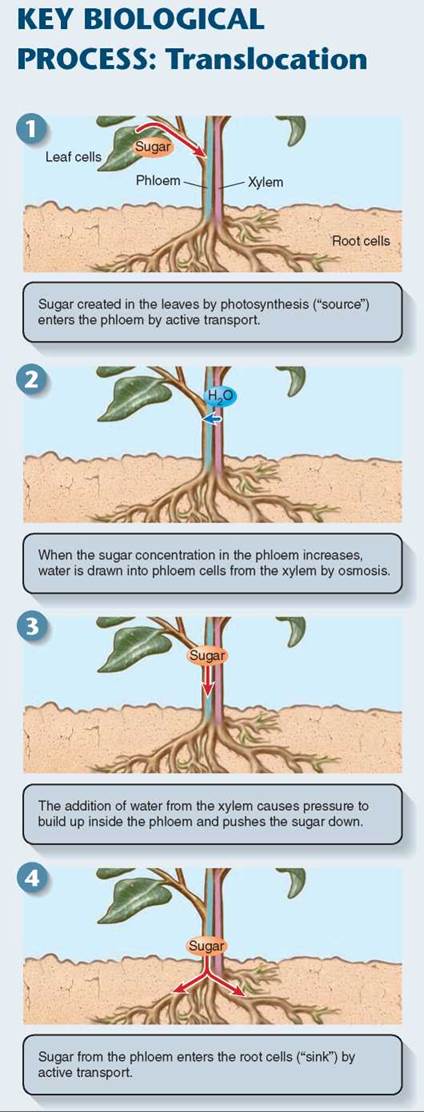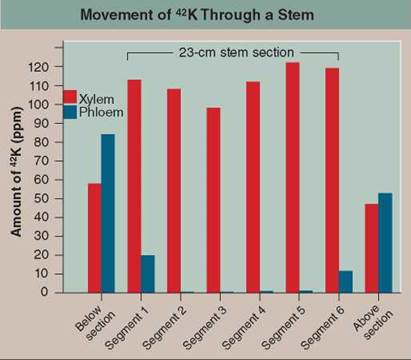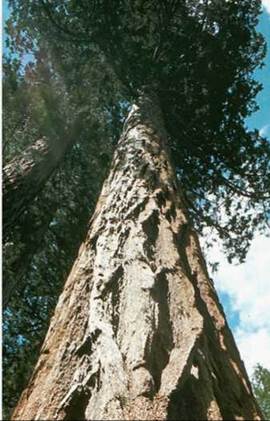THE LIVING WORLD
Unit Seven. Plant Life
Most of the carbohydrates manufactured in plant leaves and other green parts are moved through the phloem to other parts of the plant. This process, known as translocation, makes suitable carbohydrate building blocks available at the plant’s actively growing regions. The carbohydrates are converted into transportable molecules, such as sucrose, and moved through the plant.
The pathway that sugars and other substances travel within the plant has been demonstrated precisely by using radioactive isotopes and aphids, a group of insects that suck the sap of plants. Aphids thrust their piercing mouthparts into the phloem cells of leaves and stems to obtain the abundant sugars there. When the aphids are cut off of the leaf, the liquid continues to flow from the detached mouthparts protruding from the plant tissue and is thus available in pure form for analysis. The liquid in the phloem contains 10% to 25% dissolved solid matter, almost all of which is usually sucrose. The harvesting of sap from maple trees uses a similar process. The starch, stored over the winter, is converted into sap that is carried up throughout the plant. A hole is drilled in the tree and the sugar-rich fluid is drained from the tree using tubing and collected in buckets. The sap is then processed into maple syrup.
Using aphids to obtain the critical samples and radioactive tracers to mark them, researchers have learned that movement of substances in the phloem can be remarkably fast— rates of 50 to 100 centimeters per hour have been measured. This translocation movement is a passive process that does not require the expenditure of energy by the plant. The mass flow of materials transported in the phloem occurs because of water pressure, which develops as a result of osmosis. The Key Biological Process illustration on the right walks you through the process of translocation. Sucrose produced as a result of photosynthesis is actively “loaded” into the sieve tubes (or sieve cells) of the vascular bundles (panel 1). This loading increases the solute concentration of the sieve tubes, so water passes into them by osmosis (panel 2). An area where the sucrose is made is called a source; an area where sucrose is delivered from the sieve tubes is called a sink. Sinks include the roots and other regions of the plant that are not photosynthetic, such as young leaves and fruits. Water flowing into the phloem forces the sugary substance in the phloem to flow down the plant (panel 3). The sucrose is unloaded and stored in sink areas (panel 4). There the solute concentration of the sieve tubes is decreased as the sucrose is removed. As a result of these processes, water moves through the sieve tubes from the areas where sucrose is being added into those areas where it is being withdrawn, and the sucrose moves passively with the water. This is called the pressure-flow hypothesis.

Key Learning Outcome 33.7. Carbohydrates move through the plant by the passive osmotic process of translocation.
Inquiry & Analysis
Does Water Move Up a Tree Through Phloem or Xylem?
Before reading this chapter, you may have wondered how water gets to the top of a tree, 10 stories above its roots. A column of water that tall weighs an awful lot. If you were to make a tube of drinking straws that tall and fill it with water, you would not be able to lift it. The answer to this puzzle was first proposed by biologist Otto Renner in Germany in 1911. He suggested that dry air moving across the tree's leaves captured water molecules by evaporation, and that this water was replaced with other water molecules coming in from the roots. Renner's idea, which was essentially correct, forms the core of the cohesion-adhesion-tension theory described in this chapter. Essential to the theory is that there is an unbroken water column from leaves to roots, a "pipe” from top to bottom through which the water can move freely.
There are two candidates for the role of water pipe, each a long series of narrow vessels that runs the length of the stem of a tree. As you have learned earlier, these two vessel systems are called xylem and phloem. In principle, either xylem or phloem could provide the plumbing through which water moves up a tree trunk or other stem. Which is it?
An elegant experiment demonstrates which of these vessel systems carries water up a tree stem. The bottom end of a stem was placed in water containing the radioactive potassium isotope 42K. A piece of wax paper was carefully inserted between the xylem and the phloem in a 23-cm section of the stem to prevent any lateral transport of water between xylem and phloem.
After enough time had elapsed to allow water movement up the stem, the 23-cm section of the stem was removed, cut into six segments, and the amounts of 42K measured both in the xylem and in the phloem of each segment, as well as in the stem immediately above and below the 23-cm section. The amount of radioactivity recorded provides a direct measure of the amount of water that has moved up from the bottom of the stem through either the xylem or phloem.

The results are presented in the graph above.
1. Applying Concepts. What is the dependent variable?
2. Interpreting Data
a. In the portion of the stem below where the 23-cm section was removed, do xylem and phloem both contain radioactivity? How about in the portion above where the 23-cm section was removed?
b. In the central portion of the 23-cm segment of the stem (segments 2, 3, 4, 5), do xylem and phloem both contain radioactivity?
3. Making Inferences
a. In the 23-cm section, is more 42K found in xylem or phloem? What might you conclude from this?
b. Above and below the 23-cm section, is more 42K found in xylem or phloem? How would you account for this? [Hint: These sections did not contain the wax paper barrier that prevents lateral transport between xylem and phloem.]
c. Within the 23-cm section, the phloem in segments 1 and 6 contains more 42K than interior segments. What best accounts for this?
d. Is it fair to infer that water could move through either xylem or phloem vessel systems? Drawing Conclusions Does water move up a stem through phloem or xylem? Explain. Further Analysis Devise an experiment along similar lines to test which vessel system is responsible for transporting sugars produced by photosynthesis in a plant's leaves to the cells in its roots.
4. Drawing Conclusions. Does water move up a stem through phloem or xylem? Explain.
5. Further Analysis. Devise an experiment along similar lines to test which vessel system is responsible for transporting sugars produced by photosynthesis in a plant's leaves to the cells in its roots.

1. Growth in vascular plants originates in
a. photosynthetic tissue.
b. root tissue.
c. meristematic tissue.
d. leaf epidermal tissue.
2. In vascular plants, phloem tissue primarily
a. transports water.
b. transports carbohydrates.
c. transports minerals.
d. supports the plant.
3. The ground tissue that carries out most of the metabolic and storage functions is
a. parenchyma cells.
b. collenchyma cells.
c. sclerenchyma cells
d. sclereid cells.
4. In roots, growth of lateral branches begins
a. on the root epidermis.
b. on the root hairs.
c. at the ground meristem.
d. at the pericycle.
5. In stems, the tissue responsible for secondary growth is the
a. collenchyma.
b. pith.
c. cambium.
d. cortex.
6. One difference between monocot and dicot plant stems is the
a. absence of buds in monocots.
b. organization of vascular tissue.
c. presence of guard cells.
d. absence of stomata.
7. In vascular plant leaves, gases enter and leave the plant through pores called
a. stomata.
b. meristems.
c. chloroplasts.
d. trichomes.
8. Which of the following is not a process that directly assists in water movement from the roots to the leaves?
a. photosynthesis
b. root pressure
c. capillary action
d. transpiration
9. The passive process of moving carbohydrates throughout a plant is called
a. transpiration.
b. translocation.
c. translation.
d. evaporation.
10. The movement of carbohydrates through the plant is driven by
a. facilitated diffusion.
b. active transport.
c. evaporation.
d. osmosis.